Torgo
Moderator Emeritus    -segment with Crow?
-segment with Crow?
Posts: 15,420
|
Post by Torgo on Jan 19, 2012 4:08:16 GMT -5
Hahaha! 12 Angry Men and Tommy Boy honored in the same breath! I love it!
|
|
|
|
Post by Mighty Jack on Jan 21, 2012 13:24:04 GMT -5
I’ve enjoyed this so I’m going to revisit it from time to time, with looks at the honorable mentions. I put a bunch of holds on some movies at the library. A ton o' of Fellini, Blood Simple from the Coen’s and this sad tale… 113. Lust For Life (1956)While there are romantic brush strokes, director Vincente Minnelli paints a primarily accurate portrait on the life of Vincent van Gogh. The artist was an uncompromising, troubled figure, bristling with a passion for his craft that ultimately consumed and destroyed him. Kirk Douglas, a guy who rarely is able to reign in his passions on screen, was a good choice to play the tortured figure. I found myself bleeding for the guy, and related to the idea of how the creative process can posses a person. Anthony Quinn plays the bohemian Paul Gauguin - Vincent's friend, sometimes mentor, sometimes irritant - in a role that won him an Oscar. The set design, lighting and Earthy color pallet add much to the character of the film, and van Gogh’s paintings are predominately featured. www.youtube.com/watch?v=2Z3xHMNHQUs |
|
|
|
Post by Mighty Jack on Jan 24, 2012 2:58:47 GMT -5
114. The Dead Zone (1983)Another that slipped my mind: David Cronenberg takes Stephen King’s sprawling, episodic novel – captures it’s essence, tightens it up to tell a sad, moving story of a man who comes out of a coma and discovers that he has a gift -- but to what purpose? It’s a supernatural thriller with a philosophical slant. Christopher Walker was ideal casting – with those haunted eyes of his, and the feeling that he carries a great weight on his shoulders. Despite Martin Sheen’s cartoonish villain -- The thought-provoking story, crisp direction and Walken’s tragic yet sympathetic character keeps the film centered. www.youtube.com/watch?v=2tr6tJfsSDk
|
|
|
|
Post by Mighty Jack on Jan 25, 2012 0:48:02 GMT -5
115. Blood Simple (1984)It was love at first sight. I’d just caught a late night showing of Blood Simple and thought the Coen’s were the slickest dudes around. I loved the films icy hearted homage to classic film noir and its colorful cast of character actors (M. Emmet Walsh, Dan Hedaya). And while some of the gimmicky camera work was a pretentious affectation, I could live with that because the rest of the picture was so, as Roger Ebert put it, "fiendishly clever". The twisting tale is filled with slimy PIs, double crosses, knotted plots and nail biting suspense. All the elements found in the best noir. It’s not new, but it still pulls me in like a moth to the... flame? No, not flame. This is a cold story; the pitch of the film is glacial, but I ate it up. Technically it might not be the best Coen Brother’s film (arguably that honor goes to Fargo), but you never forget your first love. My Coen Favorites1. Blood Simple * 2. O Brother, Where At Thou? * 3. Fargo * 4. True Grit * 5. Raising Arizona * 6. Miller’s Crossing * 7. The Man Who Wasn't There Bear in mind that I hover between apathy (Big Lebowski) and flat out disdain (A Serious Man) on more than a few fan favs & critical darlings. It’s safe to say that my infatuation with the duo has cooled over the years. www.youtube.com/watch?v=pGS1tfb0Tmw
|
|
|
|
Post by Mighty Jack on Jan 26, 2012 7:28:27 GMT -5
#116. The Films of Veronica Lake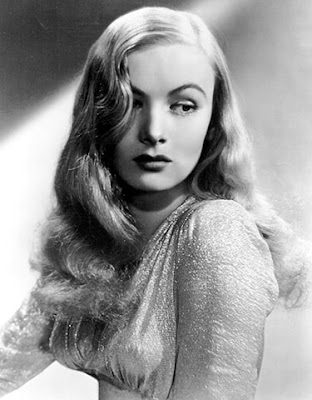 She would have been the perfect cool blond in one of Hitchcock's thrillers; her look is classic 40s Hollywood, and her famous peak-a-boo haridoo was all the rage back in the day. Lake wasn't just a pretty face, but a pretty decent actress as well, in the right role. Unfortunately she didn't have a long career. She was reportedly not a pleasant person to work with, and she later struggled with mental illness and alcoholism. Of note: Kim Basinger played a Lake look-a-like in L.A. Confidential.It’s tough to find her films. A few were released on VHS but even less made it to DVD. I wish they'd offer "I Wanted Wings", which made her a star, and "The Hour Before Dawn" which is said to have put and end to her rise to the top (she played a Nazi spy). As well as the western "Ramrod" and her last flick with frequent co-star, Alan Ladd, "Saigon". I'm not getting any younger, lets release these please. I listed 1941s Sullivan’s Travels at #25. Here are the others I've enjoyed. I Married a Witch (1942) Rated 7.7 at Rotten Tomatoes From director René Clair. An enjoyable little romantic comedy about a witch who returns to bedevil an ancestor of the man who had her and her father, burned as witches in Salem. Lake is very cute in the role, it’s one of her best, and despite the fact that they didn’t get along, she and co-star Fredric March have a nice on-screen chemistry. This Gun For Hire (1942) Rated: 7.3 Her first movie with Alan Ladd, which became one of Hollywood’s most successful screen pairings. The screenplay adapts a story by Graham Greene: Ladd plays a cold-blooded killer who is betrayed by a client. Lake accidentally gets caught up in his play for vengeance when she takes a job with the guy who betrayed him. Outstanding film noir that pulls no punches. Lake and Ladd really clicked. The Glass Key (1942) rated: 6.9 It was a great year for the actress. This is the second pairing of Lake and Ladd. Alan’s expressions are wooden (he frequently wears this stiff smile that looks pretty goofy) but he has loads of charisma. The film is a gripping tale of political intrigue and murder, adapted from a novel by Dashiell Hammett - so expect tough guys and femme fatales and a lot of snappy dialog. Lake is only one piece of a large puzzle, but it's a key role. Of Note: The story was later covered by the Coen Brothers (Miller’s Crossing). The Blue Dahlia (1946) Rated: 6.9 Raymond Chandler pens his only screenplay (and earned an Oscar nomination for it). It’s a hard-boiled murder mystery involving 3 war vets (Alan Ladd, Hugh Beaumont and William Bendix) returning home and finding trouble. Veronica Lake plays a woman who helps Ladd prove his innocence after his wife is killed. The cast is great: Nice to see Beaumont in a good movie. Chandler (a notoriously mean, abusive drunk) didn’t get along with Lake (who was no picnic herself) and he was merciless about her performance, which sadly has colored some reviewers opinions. But she does the alluring, mysterious femme fatale well. And Ladd is more natural than he was in Glass Key. The movie in full... Up next: I just checked out a bunch of Fellini from the library, movies I haven't seen in 20, 25 years. Looking forward to them and the extras |
|
|
|
Post by Mighty Jack on Jan 31, 2012 3:55:23 GMT -5
A reminder: Apart from the top 30 or 40, I’ve been throwing out titles I like in a random way, so this isn’t a strict listing. While I continue visiting the Fellini films, I took a little break from him to watch this unheralded goodie. 117. Thunderheart (1992)Michael Apted’s film mixes crime thriller and spiritualism in this tale of an FBI investigation into a murder on a Sioux Reservation. While a gripping yarn, it also digs into the plight of modern Indian. Val Kilmer stars as an agent who is given this assignment only because he has Sioux blood (though he’s out of touch with this side of himself). The always-outstanding Graham Greene co-stars as a reservation cop. The film has held up well and is still is a interesting as ever. It’s respectful of the traditions and people who live on the reservation, and the mystery held my attention throughout. www.youtube.com/watch?v=2dfmkymTr4c |
|
|
|
Post by Mighty Jack on Feb 4, 2012 0:59:24 GMT -5
#118. The Films of Federico Fellini The Italian filmmaker was initially known as a screenwriter and built up a strong resume while working with neo-realist, Roberto Rossilini. It was with La Strada that he made an international splash as a director and won the first of 5 Oscars. He eventually moved away from neo-realism and incorporated fantasy elements into his movies, a style that would be known (and imitated) as Felliniessque. Fellinni films are frequently episodic. Which creates an odd dynamic in which sometimes I really love a section of film, while other times I find a moment kind of sags. His movies are also notable for the addition of the brilliant scores composed by Nina Rota I listed 8 ½ at #31 on the 101. Here are my thoughts on others I enjoyed… I Vitelloni (1953)Fellini’s second directorial effort and the one that put him on the critical and commercial radar. The poignant story concerns 5 young friends; they are immature, and at that crossroads in life, where they either move ahead or get stuck in the rut and amass a stack of unfulfilled hopes and dreams. It’s Neo-realism and one of Scorsese’s favorites (you can certainly see the influence in films such as Mean Streets). La Strada (1954)This tragic story of a brutish traveling carnival performer and the wide-eyed woman he purchased is neo-realism, but it often breaks with traditional forms of the style (for one, it employs name actors). It's an emotional powerhouse that shows off many Fellini-isms - from the sense of journey, the circus atmosphere and characters with self-destructive tendencies. The irreverent fool (Richard Basehart) for example, keeps needling the hotheaded strongman, Zampano (Anthony Quinn, in a role that ranks among his finest). He can’t help himself (he’s the fool after all), even when he knows his actions will doom him. Giulietta Masina is memorable playing Zampano’s child-like companion. A Champlinesque figure caught between these men who are two sides of the same coin. La Strada won the very first Oscar for Best Foreign Language Film. Nights of Cabiria (1957)Episodic look at the life of a prostitute: My favorite section was when Cabiria spends a night out with a rich actor. It was such a wonderful slice of film: Both human, humorous and a sad, that I thought “They could have made a whole movie on this alone” – which of course, someone did (and they called it “Pretty Woman”) Fellini’s wife, Guilietta Masina (La Strada) is unforgettable as the title character. Cabiria is street-smart and acerbic, but when she lets down her guard she has an innocence that elicits our sympathy. The ending filled me with dread. I so wanted her to be happy, but had the sinking feeling it just wasn’t in the cards. La Dolce Vita (1960)With this, neo-realism is showing signs of giving way to symbolism and eventual surrealism. La Dolce Vita and 8 ½ are Fellini’s twin masterpieces and admirers of his work split on which is the better. (For myself, I rank it 3rd). Critic Dennis Bartok said of La Dolce, that it is what you make it “…a savage look at celebrity culture and the media; a darkly beautiful odyssey through Rome at night, with the pan-like Marcello desperately searching for his lost soul among the smoky cafes and gorgeous glitterati; a tragedy; a celebration; a mourning. It is a sign of the film’s enduring power that it is at once so seductive and so disturbing, so rich and so empty.” A work of great art, La Dolce left several cinematic marks in its wake: The sequence with an open-armed statue of Jesus flying through the air; the moment in the Trevi fountain with voluptuous Anita Ekberg. It even contributed to our language. The term “Paparazzi” came from the name of an intrusive photographer in the movie (Paparazzo). The scene that encapsulates the picture best for me - is the mad circus that surrounds 2 children who claim to have seen the Madonna. To watch the throng of sick and grieving, the opportunists and the lost souls, frantically tearing and breaking off branches of a tree where the Saint was reportedly sighted - is both humorous and sad, blasphemous and beautiful. The story is structurally challenging. It doesn’t follow the traditional 3-act play. Rather its narrative is a string of seemingly incongruent episodes, which closes without resolution. At the end, our protagonist Marcello meets his Angel. She offers him salvation but he cannot hear her, nor will he go to her. Instead he turns away and continues on his bleak, narcissistic path. Juliet of the Spirits (1965)And with this movie, Fellini gives birth to David Lynch! The director’s work has become increasingly autobiographical over the years. Juliet is about his marriage, about his dreams and his belief in spiritualism and attraction to grotesque eroticism – he threw all of this into a blender and created a psychedelic hallucination about a woman’s magical mystery tour towards self-discovery. To say it’s weird is an understatement, and while technically fascinating, it’s messy and ungrounded. But damned if the thing didn’t hold me in thrall. I couldn’t tear my eyes away. This was Federico’s first color film and it’s a dazzling, if self-indulgent, feast for the eyes. Amacord (1973)If there’s one thing to be learned from this film, it’s that Italians are obsessed with women’s butts. Set during the fascist period, Amacord is a warm and funny (with a nasty edge) look at Fellini’s youth. It was one of the director’s most popular releases, put him back into the forefront and won him another Oscar. It not plot driven but rather a series of vignettes. While OTT at times (with some childish humor), it isn’t as bombastic as Juliet & Satyricon. My favorite scene was when the town presents the large flowered arrangement formed in the shape of Musilini’s head. Very amusing. The story also draws from past films: For example - a motorcyclist who speeds through town from time to time, seems to be an allusion to Zampano from La Strada. My Fellini Favorites1. 8 ½ * 2. La Strada * 3. La Dolce Vita * 4. I Vitelloni * 5. Nights of Cabiria * 6. Juliet of the Spirits * 7. Amacord |
|
|
|
Post by Mighty Jack on Feb 8, 2012 3:43:42 GMT -5
119. Time After Time (1979)Nicholas Meyer's (The Wrath of Khan) first directorial effort. The premise supposes that H.G. Welles (Malcom McDowell) had built a working time machine and that his friend, the killer Jack the Ripper (David Warner), used it to steal away through time. The first 15 minutes of the story sets up the personalities and philosophy and even clues you in as to how it will end. But while it leaves no surprises, the journey getting there is a hell of a lot of fun. There’s humor, a love story, thrills and chills. The principal actors (including Mary Steenbergen) are all outstanding www.youtube.com/watch?v=zD39rK1uSww120. Party Girl (1995)This is the movie that helped make Parker Posey the "It Girl" for independent film. Party Girl is hilariously quirky, and the sparking Posey -playing a modern day Holly Golightly- is a big reason why this oddball romantic comedy works. Look for Liev Schreiber (Sabretooth, X-Men Origins: Wolverine") in one of his first theatrical roles. He's plays Nigel. www.youtube.com/watch?v=B9tshSME0WQ
|
|
|
|
Post by Mighty Jack on Feb 15, 2012 1:58:46 GMT -5
121. The Vikings (1958)Aside from Fran Tarkenton, Ernest Borgnine was my favorite Viking. Filmed on location in Norway and shooting for as much accuracy as they could, the film is a sumptuous visual treat. Loaded with pillaging and drinking and manly men on the high seas and engaging in sword fights. The story is pure melodrama, but it’s an entertaining spectacle. With Kirk Douglas, Tony Curtis and Janet Leigh joining the jovial Borgnine in starring roles. www.youtube.com/watch?v=z0FF9JLIj1c
|
|
|
|
Post by Mighty Jack on Feb 24, 2012 7:42:22 GMT -5
122. The Misfits (1961)I never bought into the whole 'Marilyn Monroe sex Goddess' thing. Not that she was unattractive, she was just a little too Hollywood plastic/perfect for my tastes. But I thought she was brilliant in the Misfits, I thought she looked great and her performance was her very best, most moving. The pictures script was written by her then husband Arthur Miller, with John Huston directing, and it tells the story of a divorcee who hooks up with a couple of cowboys in the Nevada desert. While it featured an all-star cast lead by Monroe, Clark Gable and Montgomery Clift, the Misfits was not a commercial success. It proved to be both Monroe and Gable’s final movie. Clark, looking fit at 59, suffered a fatal heart attack soon after the completion of the film. Gia Kourlas wrote of Marilyn’s work... “The story is less an entertaining western than a cerebral exploration of what happens when a group of discontents fall in love with the same insecure woman. Monroe's acting is superb. Huston transforms her stunning looks into something less sexy than vulnerable, and her characterization of Roslyn is full of haunting depth and subtlety.”www.youtube.com/watch?v=EckvMsLsfBM
|
|
|
|
Post by Mighty Jack on Mar 8, 2012 5:34:29 GMT -5
Articles and debates about who should or shouldn’t have won a particular Oscar have always made an interesting read. Especially when such pieces point me to great motion pictures I'd never seen or heard of. I thought it might be fun to try my hand at the exersize. In the Academy’s formative days, the film season went from August 1 to July 31 the following year. In 1934 it was changed to cover a standard calendar year. For the hell of it I’m going start my list earlier than Oscar did, using the same model - starting with 1917-18 (while I’ve viewed plenty of shorts, I haven't sampled enough features to go any earlier than this) The Felix’s: 1917 to 1927 - My Oscars before there were Oscars  1917-18 The Blue Bird (March 1918 – Director Maurice Tourneur) 1917-18 The Blue Bird (March 1918 – Director Maurice Tourneur)Nominees: The Outlaw and His Wife (Jan 1918) Stella Maris (Jan 1918) Stella Maris is a weepy soaper, notable for Mary Pickford playing 2 parts. The aptly titled, The Outlaw and his Wife from Victor Sjöström is also sentimental fare, but a strong contender for the Felix due to its powerful story of two people huddled against man and the wilds cruel nature. The one that I liked best was the kooky Blue Bird, a fairy tale about 2 kids who go off on a magical quest to find the blue bird of happiness (sadly, they did not bump into Sinbad while on their journey). The film –which anticipates the Wizard of Oz- isn’t without its flaws: While I liked the elements of the macabre (The Palace of Night), I struggled getting through the twee moral lessons. Never the less, Tourneur has a good sense of humor and a flair for visuals: The realms in which the children visit are a mixture of expressionism and art nouveau, and they are rendered in ways that are both beautiful and frightening. 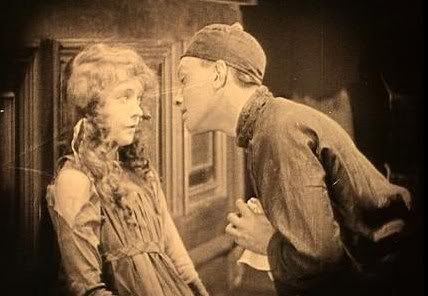 1918-19 Broken Blossoms (May 1919 – Director: D.W. Griffith) 1918-19 Broken Blossoms (May 1919 – Director: D.W. Griffith)DW Griffith was attempting to make amends after critics slammed him for the racist overtones in his film "Birth of a Nation". Blossoms tells the story of a disillusioned Buddhist, who wiles away his life in an opium den. He soon meets, and tends to a young woman (Lillian Gish) who was cruelly beaten by her abusive father – and while interracial romance was forbidden in this era, a (chaste) love blooms. Gish is an actress who does innocence undone quite well, and the scene with her hiding in a closet, trapped, insane with fear as her father hacks away at the door with an axe, is harrowing. Blossoms can be difficult viewing; the Asian fellow (played by a Caucasian) isn't even given a name (he's called the yellow man). We can only thank our lucky stars they didn’t title this thing after the book it was based on (The Chink and the Child). Still, as Roger Ebert pointed out, as naive as the movie seems today, it did help nudge a xenophobic nation towards racial tolerance. Despite some dragginess (typical of the director) this is Griffith at his most poetic, and the film's message of acceptance and love makes it worthy of a Felix. 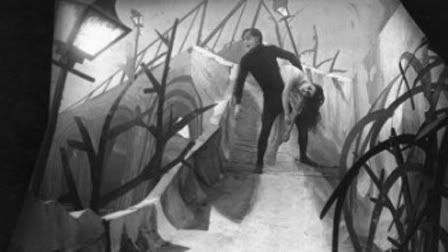 1919-20 The Cabinet of Dr. Caligari (Feb 1920 – Director: Robert Wiene) 1919-20 The Cabinet of Dr. Caligari (Feb 1920 – Director: Robert Wiene)A traveling hypnotist (Werner Krauss) sends out his somnambulant, Cesare (Conrad Veidt), to commit murder… though there just might be more to this story than meets the eye. This is strange, experimental psychological horror and one of the quintessential examples of German expressionism. Visually arresting, with skewed, abstract sets. Caligari's a seminal achievement and its impact and influence reverberated throughout the film world. This was a no brainier; the Felix for Best Picture could go to no other. 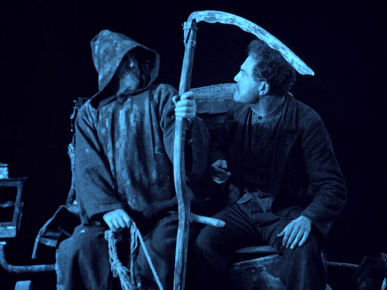 1920-21 The Phantom Carriage (Jan 1921 – Director Victor Sjöström) 1920-21 The Phantom Carriage (Jan 1921 – Director Victor Sjöström)Nominees: The Last of the Mohicans (Nov 1920), The Golem (Oct 1920), The Kid (Jan 1921) American audiences know Victor best as the lead actor in Ingmar Bergman’s Wild Strawberries - but as a director he was the father of Swedish cinema. Carriage is based on a Scandinavian legend that says that the last person to die on New Years Eve is doomed to drive the chariot that carts off the souls of the dead. A sinful man faces that fate and attempts to redeem himself to avoid it. Being Swedish, it is as expectedly slow as it is expectedly visually interesting. Sjöström mixes Victorian sentimentality and modern psychology to tell a tale that echoes Dickens "A Christmas Carol". More Felix's soon... |
|
Torgo
Moderator Emeritus    -segment with Crow?
-segment with Crow?
Posts: 15,420
|
Post by Torgo on Mar 8, 2012 13:57:56 GMT -5
Ahahaha...the "Felix's"...took me a few seconds, but I got it.
|
|
|
|
Post by Mighty Jack on Mar 9, 2012 0:43:25 GMT -5
^Glad you got the joke Torgo.  And the Felix for Best Moton Picture goes to... And the Felix for Best Moton Picture goes to... 1921-22 Nosferatu, a Symphony of Horror (March 1922 – Director: F.W. Murnau) 1921-22 Nosferatu, a Symphony of Horror (March 1922 – Director: F.W. Murnau)Nominees: Nanook of the North, Dr. Mabuse the Gambler Bram Stoker’s widow was so upset over the theft of her husband’s story, that she demanded that all prints of Murnau’s classic be destroyed. Thank goodness she didn’t get her wish, as we all would have been the poorer. German Director F.W. Murnau was an artist who brought a distinct style and look to the feature. He was also a man who understood how powerful subtlety and atmosphere could be within the realm of horror. The gothic vampire story is boosted by the look of the piece, the shadows are every bit a character here - plus there’s the memorably chilling performance from Max Schreck as Count Orlok. There were several notable films to pick from in 1921-22: Fritz Lang’s Dr. Mabuse, and one of the first documentaries (Nanook), but the story of Orlok trumps them all.  1922-23 La Roue (Feb 1923 – Director: Abel Gance) 1922-23 La Roue (Feb 1923 – Director: Abel Gance) Nominees: Safety Last (April 1923), The Covered Wagon (March 1923), Häxan (Sept 1922), Robin Hood (Oct 1922) Abel Gance's La Roue is a flawed, but ingenious slice of French impressionistic cinema. At times I nearly choked on the syrupy melodramatics of it all. But it’s such a technical achievement, a trendsetter of edits and style, that I feel compelled to award it the Felix on those merits alone. From the memorable train sequence, to a moment where we see a man in the last moments of life, having a flashback of his true love that are shown in a succession of rapid fire images, it’s a visual marvel if nothing else. Jeffery M. Anderson said it best when he wrote, "Gance took this moldy, soapy story about a railroad man who adopts a young orphan girl and turned it into a sprawling, half-mad, 4-1/2 hour masterpiece."The Nominees: The Covered Wagon is an influential western, which has grown a bit stale. Haxan is an interesting piece about superstition. It offers some visual treats, but there are these static bits where the movie stops to give –what amounts to- history lessons. Robin Hood was a huge budgeted extravaganza (and the first movie to have a Hollywood premier). It starred Douglas Fairbanks in the title role, and Alan Hale Sr. (The Skipper’s papa) as Little John. Safety Last is the Harold Lloyd comedy classic, and I was real tempted to pick it. But I elected to go with Gance and save Lloyd for the following year. 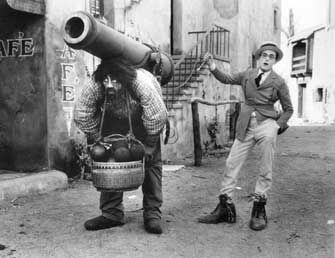 1923-24 Why Worry? (Sept 1923 – Directors: Fred Newmeyer & Sam Taylor) 1923-24 Why Worry? (Sept 1923 – Directors: Fred Newmeyer & Sam Taylor) Nominees: Sherlock Jr. (April 1924) Comedy was king in the 20s, lead by the brilliant trinity: Chaplin, Keaton and Lloyd. Comedians understood the importance of timing better than anyone. While some of the silent era dramas can come off dated, too theatrical and melodramatic, with scenes that go on longer than they should. Silent comedies hold up to the test of time. Harold Lloyd's tale of a hypochondriac on vacation, who winds up caught in the middle of revolution, is as fresh and funny as ever. It's a shamefully overlooked gem, deserving of more respect than it receives. Saying that, I was real tempted to go with the tie here, as I equally love Keaton's inventive technical achievement that was Sherlock Jr. I couldn't go wrong with either film |
|
|
|
Post by Mighty Jack on Mar 10, 2012 1:33:42 GMT -5
And the Felix for Best Motion Picture goes to...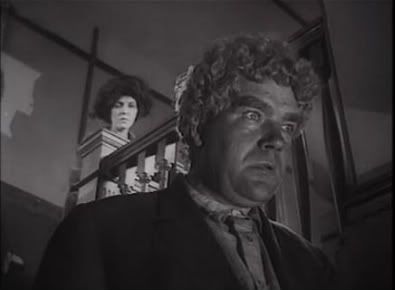 1924-25Greed (Dec 1924 – Director: Erich von Stroheim) 1924-25Greed (Dec 1924 – Director: Erich von Stroheim) Nominees: The Gold Rush (June 1925), The Navigator (Oct 1924), Seven Chances (March 1925), HE Who Gets Slapped (Nov 1924) Greed has been called the greatest film never seen. By demand of the studio Stroheim took his initial 10 hour film, cut it down to about 6, after which it was taken out of his hands and whittled away to a mere 2 + hours. In 1991, using still pictures to fill out what was lost –the stories contrasting sub plots and supporting characters are restored, lengthening the picture to over 4 hours. It’s a mess, but even in this mangled form a masterpiece emerges. Stroheim’s tale of soul crushing avarice is still powerhouse cinema. Actor Gibson Gowland as McTeague is an impressive figure, a brick of a man with a shock of curly hair. He's got a magnetic screen personality that would have carried the movie whether it was 4, 6 or 10 hours long. He’s aided by Zasu Pitts, playing his wife who wins the lottery that set this tragic tale into motion. With these performances, a strong story and notable camera work, which included hand tinted gold objects popping up on screen from time to time, Greed stands as the years best in whatever form it takes. The film year also offered up other significant nominees. From Buster Keaton’s brilliant Navigator and 7 Chances, to Chaplin’s benchmark, the Gold Rush. Victor Sjöström was also in the mix with the acclaimed Lon Chaney film HE Who Gets Slapped. 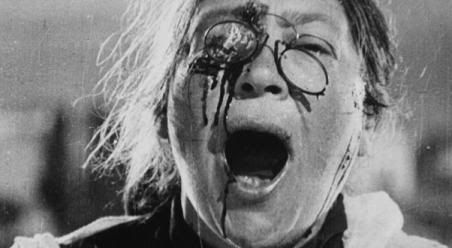 1925-26 Battleship Potemkin (Dec 1925 – Director: Sergei Eisenstien) 1925-26 Battleship Potemkin (Dec 1925 – Director: Sergei Eisenstien) Nominees: The Freshman (Sept 1925), Go West (Nov 1925) Eisenstein’s editing style changed the way movies looked and Potemkin will forever be linked to its textbook examples of montage. The way he cut from action, reaction and closeup was influential and the main focus of discussion on the movie. But Potemkin was also an early example of realism. Film had been magical and theatrical, now it would rip away the gloss and greasepaint and show humans and the human condition, warts and all. A prime example of that: The famous Odessa step sequence, remains one of filmdoms most powerful moments. It’s interesting to note that this story was touting its support for communism, it was a desperate cry for a break from tyranny - and knowing how that cry will eventually turn to tears itself, adds to the haunting nature of the movie when viewed today.  1926-27 The General (Feb 1927 – Director: Buster Keaton) 1926-27 The General (Feb 1927 – Director: Buster Keaton) Nominees: Metropolis (Jan 1927), Napoleon (April 1927), Mother (Oct 1926), The Kid Brother (Jan 1927) I don’t know what more I can say about my love and admiration for Buster Keaton’s The General. It’s the greatest silent comedy and one of the greatest silent films ever made. The genius of the General is what pushed another classic out of the top spot, that being Metropolis. And I know a few will disagree with me on this one. But for me, Lang’s picture is #2. #3 is Abel Gance’s innovative biogpic, Napoleon; Among it’s dazzling visuals - in its final scenes it used a precursor to cinemascope, called Polyvision. From Wiki: The film is recognised as a masterwork of fluid camera motion, produced in a time when most camera shots were static. Many innovative techniques were used to make the film, including fast cutting, extensive close-ups, a wide variety of hand-held camera shots, location shooting, point of view shots, multiple-camera setups, superimposition, underwater camera, kaleidoscopic images, film tinting, split screen and mosaic shots, multi-screen projection, and other visual effects.After that: Mother is an intimate kin to battleship Potempkin, a realistic Russian film about socio/political issues. The Kid Brother was a Harold Lloyd comedy. Up next: Felix vs. Oscar! (Though I need to see a few of the top ranked movies first)
|
|
|
|
Post by Mighty Jack on Mar 10, 2012 22:14:28 GMT -5
1927 to 1933: The birth of the Oscar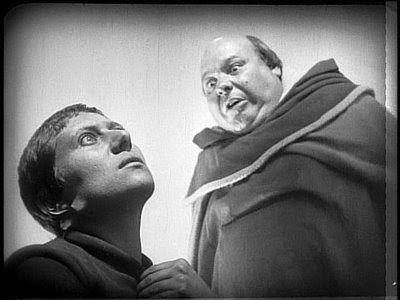 1927-28 The Passion of Joan of Arc (April 1928 - Director: Carl Theodor Deyer) 1927-28 The Passion of Joan of Arc (April 1928 - Director: Carl Theodor Deyer)Nominees: Sunrise, Steamboat Bill Jr. The Crowd, Seventh Heaven Oscars pick: Wings (also Sunrise)Oscar’s nominees: The Racket, Seventh Heaven (Also The Crowd, and Chang: A Drama in the Wilderness) Originally the Academy didn't have a Best Picture winner, they had two: “Outstanding Picture” (Won by Wings) and “Unique and Artistic Production” (won by Sunrise). Later on they changed it to a single feature and decided Wings best fit the criteria, which is why it is considered the Best Picture winner today. Also, since this was the first Oscar, the film year started at the beginning of 1927 (ending July 31st 1928). Which means they could have, but didn't nominate, the General, Metropolis or Napoleon. Weirdos!Wings is actually a very good picture. A little soapy, but the aerial shots are ground breaking and breathtaking. I have nothing against it. It’s just that there are greater motion pictures. At the top of the eligible films (my adaptation of the Oscar model) were 2 works of genius: Sunrise and The Passion of Joan of Arc (and if you throw in the 3 I mentioned before that they could have also nominated – and this could have gone down as the greatest group of nominated pictures in Oscars history) On Sunrise, a Song of Two Humans: Politicking was in full force. Louis B Mayer disliked the realism of King Vidor’s groundbreaking The Crowd, so much so that he pressured judges to select Sunrise instead (plus he was probably pissed that the ‘happy’ ending he forced Vidor to use, was jeered at by audiences. Later, King’s better, ambiguous ending was restored). Right off the bat the Academy makes a mockery of itself. Regardless, Sunrise is deserving of praise. F.W. Murnau’s tale of love betrayed and love renewed is an amazing looking picture (the copy in the Murnau, Borzages and Fox box set includes an informative commentary track that details the cinematography and camera angles in worshipful tones). Many feel it’s the greatest film of the silent era. The only thing I didn't care for was the overly theatrical stuff from best actress winner, Janet Gaynor. Also worthy of consideration is Keaton’s Steamboat Bill Jr. and Seventh Heaven, which won Frank Borzages the first Oscar for directing. It’s a sappy/soapy but worthwhile love story about a street cleaner and a streetwalker who fall in love. But for me the most amazing movie of them all is one that didn't earn a nomination. It’s Carl Theodor Deyer’s The Passion of Joan of Arc. This silent classic was lost in a fire, not once, but twice. In the 80s a print was located in the closet of an insane asylum! Restored and reissued, it reveals itself as a work of high art. Dreyer used tight close-ups throughout, and his eye for space and composition is both astonishing and disconcerting. Disconcerting because Deyer breaks all the rules of camera work (see link bellow) - I can’t find adequate words to describe how fresh and exhilarating a viewing experience it was for me. Simply put, it’s a benchmark of experimental cinema. Passion features stage star Maria Falconetti's lone appearance on film, and it’s one of the greatest pieces of acting I've ever seen. I've long held the belief that Marlon Brando's work in On the Waterfront was the best performance by an actor ever presented on screen. Well, I have now discovered someone who challenges that claim. There was a lot asked of the actress -what with all those close-ups- and she delivers in every way possible Therefore, as much as I loved The Crowd and Steamboat, liked Heaven, respect Wings and wouldn't argue with anyone who would select the brilliant Sunrise as the top dog. Passion is my pick for the Felix. Note: To read more insights on the movie, check out Matthew Dessem’s wonderful blog (in which he watches and reviews every Criterion release) criterioncollection.blogspot.com/2006/11/62-passion-of-joan-of-arc.html
|
|